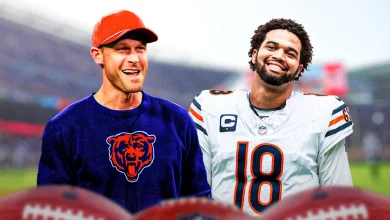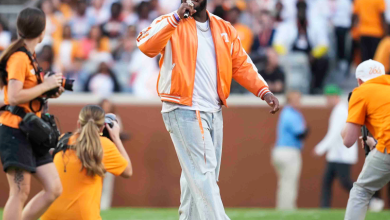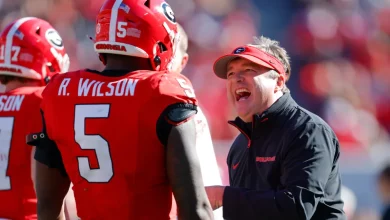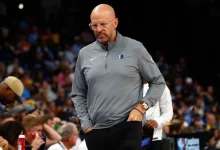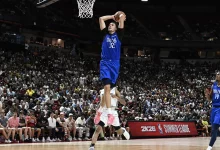“The Curse of Rowdy”: Since the debut of their mascot, the Cowboys have failed to win a Super Bowl.
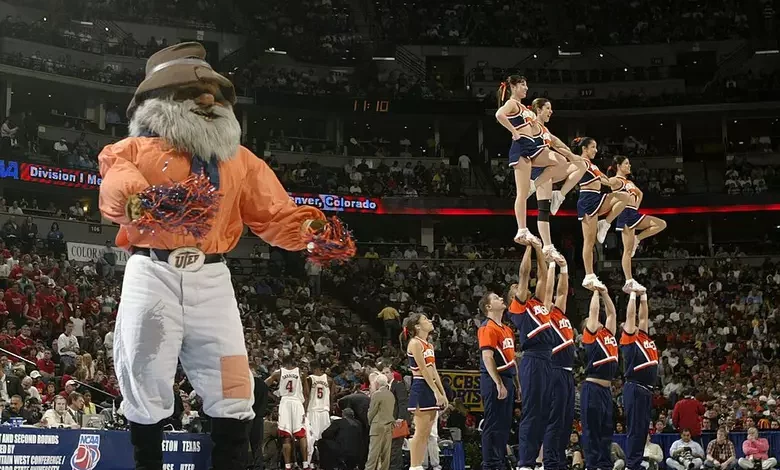
The Dallas Cowboys are one of the most iconic and successful teams in NFL history. They have won five Super Bowls, appeared in eight, and earned a reputation for being “America’s Team.” However, in a twist of irony, since the debut of their beloved mascot Rowdy in 1996, the Cowboys have experienced a noticeable drought in Super Bowl championships. This long-standing period of playoff disappointment has led some fans and analysts to wonder if there might be something more at play—a curse of sorts—that ties the team’s inability to win another Super Bowl with the introduction of Rowdy the Cowboy.
While some might dismiss the idea as superstition or pure coincidence, the timing of the team’s struggles coinciding with Rowdy’s debut has led to some amusing, albeit speculative, theories. From missed opportunities to heartbreaking playoff losses, many fans can’t help but look at the introduction of Rowdy as a symbol of a shift in fortune for the Cowboys. Could there really be a “Curse of Rowdy,” or is it simply a narrative of frustration tied to a team that has been incredibly close but just not quite able to finish the job?
In this article, we’ll take a deeper look at the timeline of the Cowboys’ success and failure, explore the significance of Rowdy’s debut, and examine whether there’s any substance to the idea that the team’s mascot could be the reason they haven’t claimed a Super Bowl since the mid-90s. Whether you’re a die-hard Cowboys fan or just an NFL observer, the idea of a curse is always intriguing—and in the case of Rowdy, it’s certainly worth exploring.
The Dallas Cowboys’ Golden Years (1970s to Early 1990s)
Before we dive into the curse theory, it’s important to reflect on the Cowboys’ legacy of success prior to the mascot’s debut. From the 1970s through the early 1990s, the Cowboys were a dominant force in the NFL. Under legendary coaches such as Tom Landry and Jimmy Johnson, the Cowboys consistently contended for championships and established themselves as one of the most successful franchises in league history.
The team’s golden era began with Landry at the helm, who led the Cowboys to two Super Bowl victories in 1971 and 1977. By the time the 1990s rolled around, the Cowboys were firmly established as an elite franchise, thanks to a mix of savvy management, innovative coaching, and a talented roster. Under Jimmy Johnson, the Cowboys returned to prominence, winning three Super Bowls in the 1990s (Super Bowls XXVII, XXVIII, and XXX) with stars like Troy Aikman, Emmitt Smith, and Michael Irvin leading the way. The team’s success in the 1990s made them one of the most dominant forces in the NFL, and the future appeared bright.
However, after their victory in Super Bowl XXX in 1996, the Cowboys’ fortunes began to change. It was around this time that the team began its slide from perennial Super Bowl contender to a franchise searching for the formula that would return them to the top. Little did fans know that 1996 would mark a pivotal year—not only for the team on the field but for the team’s marketing efforts off the field as well.
The Debut of Rowdy the Cowboy (1996)
The Dallas Cowboys introduced Rowdy as their official mascot in 1996, and for many fans, he became an instant fan favorite. Rowdy was designed to represent the spirit of the Cowboys: an enthusiastic, larger-than-life cowboy figure who would rally the crowd and engage with fans at home games. Rowdy’s appearance was intended to complement the team’s iconic branding and legacy while also engaging a new generation of fans.
Rowdy’s debut, however, coincided with a turning point for the Cowboys on the field. After winning Super Bowl XXX in 1996, the Cowboys failed to reach the same level of dominance they had enjoyed in the previous decade. Despite having a solid roster, the team’s success began to diminish, and the team entered a new era of uncertainty.
In 1997, just one year after Rowdy’s introduction, the Cowboys suffered a disappointing playoff loss to the Green Bay Packers in the NFC Divisional Round. While the team was still competitive, the next few years saw them fall short of expectations. Troy Aikman’s retirement, Jerry Jones‘ interference in team operations, and inconsistent coaching decisions resulted in a noticeable decline. By the early 2000s, the Cowboys were no longer Super Bowl contenders, and they were in the midst of a rebuild.
In fact, the team would not return to the NFC Championship Game until 2014, and their last Super Bowl appearance remains a distant memory, despite making the playoffs numerous times. Fans who remembered the glory days of the 1990s began to grow frustrated, and a sense of inevitability set in: the Cowboys would make it to the playoffs, but they would never quite finish the job.
This period of playoff frustration has led to the theory that Rowdy’s debut in 1996 marked the beginning of a “curse” that has plagued the team ever since. As absurd as it sounds, this narrative has been brought up by fans and commentators who can’t help but notice the correlation between the mascot’s introduction and the team’s subsequent struggles to win a Super Bowl.
The Curse of Rowdy: A Symbol of Frustration?
So, is there any real substance to the theory of a “Curse of Rowdy”? While the idea of a curse is purely speculative and rooted in the realm of superstition, it’s difficult to ignore the timing of the Cowboys’ decline after the debut of their mascot. Here are a few key moments and trends in Cowboys’ history since 1996 that fuel the idea of the curse:
1. The Decline After Super Bowl XXX (1996)
As previously mentioned, the Cowboys won their fifth Super Bowl in 1996, defeating the Pittsburgh Steelers in Super Bowl XXX. This victory marked the pinnacle of their success during the 1990s. However, after Rowdy’s debut in 1996, the team’s fortunes began to shift. The Cowboys failed to win another championship, and the 1990s dynasty was never fully revived.
2. Inconsistent Playoff Appearances
Since Rowdy’s arrival, the Cowboys have consistently made the playoffs but have struggled to make deep runs. Whether it was a crushing loss to the Packers in 1997, a tough defeat to the Giants in 2007, or an early exit at the hands of the San Francisco 49ers in 2021, the Cowboys have repeatedly been eliminated at critical stages, preventing them from ever truly contending for another title.
3. The Quarterback Carousel and Coaching Changes
While the Cowboys were fortunate to have Troy Aikman lead them through their Super Bowl years, his retirement and the lack of a consistent quarterback in the post-Aikman years left the Cowboys without a steady hand at the helm. The revolving door of coaches, from Chan Gailey to Bill Parcells to Wade Phillips to Jason Garrett and ultimately Mike McCarthy, has further contributed to the feeling that something has been off with the franchise since Rowdy’s arrival.
4. Star-Studded Teams That Underachieved
Despite having incredible talent at key positions—such as DeMarcus Ware, Tony Romo, Dak Prescott, Zeke Elliott, and CeeDee Lamb—the Cowboys have continually underachieved when it matters most. Super Bowl-caliber rosters have failed to even reach the NFC Championship Game. With a mixture of bad luck, inconsistent performances, and playoff blunders, fans have struggled to reconcile the team’s inability to live up to its potential.
Is It Really a Curse?
Of course, most reasonable fans and analysts would argue that there is no actual “curse” tied to Rowdy’s debut in 1996. The Cowboys’ struggles are likely the result of a combination of poor management decisions, roster miscalculations, and inconsistent play on the field. Football, after all, is a game of inches, and the Cowboys’ misfortune in the post-1996 era can likely be attributed to factors far more complex than the arrival of a mascot.
That being said, the idea of the “Curse of Rowdy” persists as a humorous way to explain the Cowboys’ continued inability to win another Super Bowl. It allows fans to vent their frustrations and create a narrative around the team’s long-standing playoff failures. Whether it’s bad luck, bad decisions, or simply a lack of execution, the Cowboys’ failure to win a Super Bowl in the Rowdy era remains a mystery to many, fueling conspiracy theories and curses along the way.
The Cowboys’ Quest for Another Super Bowl
While the introduction of Rowdy in 1996 may have coincided with the start of a Super Bowl drought for the Dallas Cowboys, it’s ultimately a coincidence—or at least that’s what most would argue. The true causes of the Cowboys’ failure to return to championship glory lie in organizational missteps, missed opportunities, and a series of tough breaks. The idea of a “Curse of Rowdy” may be a fun narrative to explore, but it is more an expression of fan frustration than an actual force affecting the team.
Despite their playoff disappointments, the Cowboys remain one of the most storied franchises in NFL history. The search for another Super Bowl continues, and perhaps with the right mix of talent, coaching, and execution, Dallas will once again find themselves hoisting the Lombardi Trophy—no matter what mascot is on the sidelines.
For now, the Curse of Rowdy remains just a fun tale to tell, as Cowboys fans hold out hope that one day their team will return to the pinnacle of the NFL.



